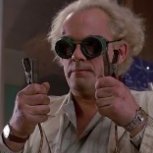Leaderboard
Popular Content
Showing content with the highest reputation on 12/23/24 in all areas
-
I'm curious how folks are or are planning to deploy media streaming at home. I ask because my current (old) NAS supports DLNA as does my TV. So, simply creating a Movies folder with my content that is easily accessed by the TV and boom...we watching some flicks. However, with the new NAS and HexOS I'd like to explore alternatives (when made available). I've used Plex many years ago and while their lifetime $120 (I think?) price seems fine, I do not want to jump to Plex just because it's available. I can wait. My setup is simple and can be seen HERE. Internet line in to Netgear router with both old and new NAS's attached via Cat6. I only have wifi to stream as @Mawson isn't close enough to run low voltage. Which is to say, all the hardware is upstairs and all/most of the viewing occurs downstairs. So what are y'all planning to do to stream at home? Thanks!1 point
-
You need to login into Truenas, go to storage -> Manage Devices -> select your pool and then the first drive. On the right side on the Disk Info part press "Edit" and there you have the possibility to set the HDD Standby and/or Advanced Power Management. Under Advanced Power Management everything from Level 1 to 127 will spin down the drive, from 128 to 254 will not spin down the drive. You have to do this for every HDD. I don't know how Hexos is reacting to this and which side effect it can have, also for other people reading this, spinning down drives is generally not recommended because the spin ups are putting wear on the drives, and drives are vulnerable during spin ups. When drives are spinning there is an air cushion which is keeping the head of the disks, while this is not the case during a spin up and a head crash can occur. Also when leaving a drive sitting without spinning it can have a negative impact on the lubrication of the bearing. Also make sure that the drive doesn't not cool down to much, this is especially import in the winter if the server is sitting in a cellar or basement where the air temperature can drop and this can also cool down your drive significantly, depending on your setup. There have been plenty of perfectly working drives without issues, which did not recover from a spin up. So be warned, that it might shorten the lifespan of a drive. Also you might want to look into enabling the different C-States in the Bios, this can also save a significant amount of energy.1 point
-
I guess I was looking at it as a good starting platform, comes barebones in a case with plenty of room for expansion, more power efficient than the old 32nm chip you originally looked at being a more modern 14nm chip. They can be had barebones for $150 on ebay with a W-2135 CPU or you could step up and spend more to get more cores. I am still hashing out if I want to go this route or stick with a consumer i5/i7 system. Lots to learn.1 point
-
Hey, Concerning the RAM, go with ECC modules. Just a quick heads-up, Hexos is using ZFS, which is different then raid and has a different naming scheme. For example the RAID1 in ZFS is called mirrored, RaidZ1 in ZFS would be similar to Raid5, RaidZ2 would be similar to Raid6. Therefor to not get confused between Raid1 (ZFS mirrored) and ZFS RaidZ1 (Raid5) I will use the ZFS terms. Mirrored boot drive is the way to go with the current version of Hexos. Since pool import is not supported at the moment, if you only have 1 boot drive and if your boot drive bites the dust, there is currently no way to use hexos again without loosing all your data. You would need to install truenas and use truenas until Hexos supports pool import. I am using WD Red Plus and Seagate Ironwolf drives, they are meant for NAS and should last longer in theory. However a lot of people are using desktop grade drives without much issue. My only recommendation would be to make sure you get CMR drives and not SMR drives (meaning don't buy for example normal WD Red drives, either use the Red Plus or Red Pro for those) If you are only using it as a NAS and don't want to host a lot of other things and VMs, 1 CPU would be more than enough, this will save on energy. Additionally, you can also activate some of the C-States in the BIOS to save even more energy on idling and you can disable not used components (audio chip on consumer grad HW, onboard NICs if an external NIC is used etc...) Stopping drives from spinning would also save some energy, however this is generally not recommended since it increases the wear on the drives, spinning drives up is one of the more frequent cases where a drive can die.1 point
-
You are better off using 3.5" drives if you can for it I'm your chassis. Majority of 2.5" hdd are smr drives that didn't play nice with zfs, which is what hexos uses. There are a few 1tb cmr 2.5" hdds out there but a lot of them have been discontinued and the rest are kind of hard to find. If you only have 2.5" slots available either find the few cmr drives or go sata ssd. Consider going with fewer but larger hdds since each one uses a decent amount of power. I personally bought a lot of exos drives new from eBay. But again this is only an option if you use 3.5" drives. Mirrored boot partition is more responsible but if your server isn't mission critical and just a home nas i would skip the mirror.1 point
-
@Mobius It looks like Jellyfin might be the way I want to go. Seems super flevible and FREE! Between that and tailscale I hope I can get my content locally and remote. @Mawson That's just some next level ish I hadn't ever considered nor knew was possible. Your own dedicated channel streaming what ever you want? I have all of the original Doctor Who and Star Trek TOS shows and would totally hook that up. That's some (m)awsome stuff!! (you see what I did there?) 😁1 point
-
That is the EXACT reason the Netgear is facing the wall. That damn blue light could land an airplane!1 point
-
Right now I'm fiddling around with Plex, since it is curated. I'll probably end up on Jellyfin. What I would LOVE to have in addition to jellyfin is some way to create my own virtual TV channels. There are a few people on Youtube that are taking Rpi's and old commercial RF modulators and to create their own analog TV channels on their homes' coax networks. I want to create this same concept just digital. So the content would be on a set schedule (vs on demand), but it would still be streaming. Here's a link to one of the videos of someone who has an RF local TV setup:1 point
-
I use jellyfin since its not bloated like plex and is free. It also gives me the freedom to use most every file format. I do stream content to apple tvs i have throughout the home using the infuse app (i think it was like $99 for a lifetime sub). I don't think i had to transcode at all since i setup infuse on the apple tv. I had a family member that used to watch movies streamed to his ipad using the same infuse license. On my android devices i don't even need a third party app since the jellyfin app works fantastic. The flexibility is just convenient to me since i don't always want to watch on my tv.1 point
-
1 point
-
Thanks @jonp! That’s already 100 times better 😃1 point
-
1 point
-
I told you you this guy ^^^ is a thread ninja! Thank you @Mawson this is logical, relevant and super helpful!1 point
-
@Mobius, @Theo, @PenguinKing, @Dylan, @jonp I love this idea! Things like this are what make a community great. I agree that a separate sub-forum would be ideal. Possibly 'Support > Guides and Tutorials'. EDIT: All right gents! The wheels are in motion!1 point
-
Currently setting up a server with 10 drives that I may access only about once or twice a week. would really like to know if this is an option as well. it would just very unnecessary energy cost and drive wear.1 point
-
Electricity prices are crazy. I calculated that leaving 2 HDD's off for 16 hours per day will save me enough for either one 2kg chicken or 1kg of cheese. I really need to know how to turn on HDD power down.1 point
-
It most certainly is for many people in many countries.1 point
-
I was about to post the same. The app preview window needs to stay visible.1 point
-
It would be a very useful to be able to connect an external hard drive and then copy data from this directly, rather than needing a second computer and a (potentially) slow(er) network connection. Especially since/if this is targeted at non-professionals who will quite likely currently have things backed up on an external hard drive.1 point
-
Hi there! We certainly would like to add a bunch of game servers, but it might take a little while.1 point
-
There is a “disconnect this server” button which will open up that license to be used on another server. I currently have Hex OS on a VM and am planning a full migration once I feel it’s ready.1 point
-
i chose to pass my RAID card to my TrueNAS scale and i run my storage on it. any containers i want are running on a separate ubuntu VM with docker, though now that TrueNAS (and thus HexOS) supports docker (rather than kubernetes (which im illiterate at), there's no actual reason for me to do that anymore. go with whatever is most convenient for you to diagnose. everything else is secondary. you won't feel the the difference in overhead of any solution.1 point
-
It seems to work flawlessly if you install it in the truenas UI so I’m sure it would be an easy addition.1 point








.thumb.jpg.d425f5686578c997f4b542ab07344f79.jpg)

